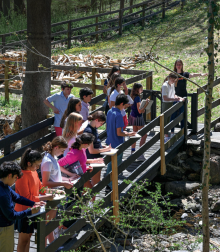
By Stephanie Rapciak, Middle School Science Teacher
The first thing that Evie Harrison noticed when she arrived at Old Church Road as a new Middle School Science teacher two years ago was the bountiful nature. “I remember being impressed with how beautiful the campus was and how much access there was to the natural world and outdoor spaces.”
As we spend more time indoors and technology begs more of our attention, it is easy to create boundaries between the human experience and the nature that surrounds us. With that in mind, Morgan Withrow, Evie Harrison, and I sought to give seventh-grade students an authentic opportunity to explore our vast campus. In the spring of 2022, we developed a new field ecology unit with one simple and important goal: for our students to form a personal connection with GCDS’s ecosystem.
Creating a Field Notebook
Up until this point, a seventh-grade science unit typically began with students organizing teacher-created worksheets in their science binder. To embark on a unit with such a personal goal, we knew that their daily work had to be more distinctive, unique, perhaps messy. For the next several weeks, students set aside their binders in favor of a new tool—a field notebook. Before venturing into the field, we studied the field notebooks of professional ecologists. Some were driven by numerical data and others contained expressive sketches of organisms in the field. Students learned how ecologists note down observations, questions, locations, and the environment. They noticed how the notebooks were similar to personal diaries, and practiced making their own entries. Equipped with their new field notebooks, students began to closely observe their own ecosystem.
Studying the Ecosystem in an Outdoor Classroom
We first studied an often-overlooked aspect of our campus: the power of water. As students rock-hopped down the (unofficially named) Gneiss Creek, they noticed weathered rock, examples of erosion and deposition. They came upon the confluence with the larger Greenwich Creek, which raised questions about how Ice Age glaciers sculpted the twists and turns into the land we use today. We went outside to answer questions about the Stone Cottage, rock walls, and the curious striations on the outcropping of bedrock by the Dining Hall.
As the weather gradually warmed from late winter to early spring, students asked more questions about the vast array of nature’s changes. After a particularly heavy rain, a proliferation of algae sprouted in the pond, seemingly overnight. To investigate, students conducted water quality tests to learn how elevated levels of nitrates and phosphates—often caused by agricultural runoff—can decrease dissolved oxygen levels needed by aquatic life. When trees started to bloom and seeds covered the sidewalks, students learned about seed dispersal, germination, and photosynthesis. The athletic field, dotted with robins searching for worms, was an idyllic classroom for a lesson on biotic community and population ecology. The bam-boo forest sparked conversations about invasive species and how they disrupt evolved food webs and demand ecological resources. In each successive trek through our campus, students had more tools and knowledge to observe and connect to their surroundings.
After studying various aspects of the GCDS ecosystem, students were ready to start their final projects. To kickstart inspiration, we asked them to pick their favorite observations or questions from the unit. This process generated a vast and diverse group of topics. Some students wanted to study glaciation, others were curious about the diversity of wildflowers, and some wondered about the impact of pollution. Once they connected with a final topic, they needed to determine what they would create to demonstrate their learning.
Looking Back, Thinking Ahead
The anticipation of beginning the second year of this unit led us to wonder about other ways to engage students across the boundaries of academic disciplines and classroom borders. Presenting our project during the GCDS Professional Learning Day in February (see story on page 10) prompted many of our creative colleagues to share ideas for interdisciplinary connections through dance, song, and visual art. Middle School Art Teacher Keith Simpson noted, “When hearing about the exciting field ecology projects, the first thing I thought about was carbon-based black inks, charcoal, and even candle soot black. Students could use these raw materials for artwork while appreciating the carbon cycle. How amazing is it that a tree builds itself from breathing in carbon, and students can extract and draw with it?!” In many ways, the ever-evolving nature of this interdisciplinary project mirrors a fundamental truth of our ecosystem; there is strength in connectivity.
Science & Art Connection
How could students demonstrate a deeper connection to nature? We wanted the final projects to be as diverse as their observational prowess, so students learned about professional role models whose work reflects deep observation: field ecologists, environmental activists, painters, sculptors, poets. The connection between the work of scientists and artists was surprising and intriguing to many students.
Ben Gaspar ’28 was interested in the artistic route early on. “When I noticed some flowers starting to bloom on our hike, I thought it would be cool to know all of the flowers that bloom on our campus. Ms. Withrow told me that this would be a great topic for an artistic project. I had no idea that this observation could turn into a project, but I was excited to start,” he said.
Anika Khichadia ’27 and George Athanasopoulos ’27 conducted a photographic study to determine which flowers attracted the most pollinators. Jelani Brown ’27 and Jack Rubenstein ’27 wanted to know the nitrate levels at different locations of Gneiss Creek. Ellie Hillenbrand ’27 observed numerous aspects of blue jays and created detailed watercolor diagrams.
As the projects developed, Morgan Withrow reflected, “As a veteran teacher of 16 years, I can say with confidence that this unit has been my favorite. Students were fueled by curiosity and were excited to discover more about our campus. It was fascinating to see the range of students’ ideas. At the start of the project phase, no one is left without an idea and I have never encountered that before.”











.JPG&command_2=resize&height_2=85)





.jpg&command_2=resize&height_2=85)




